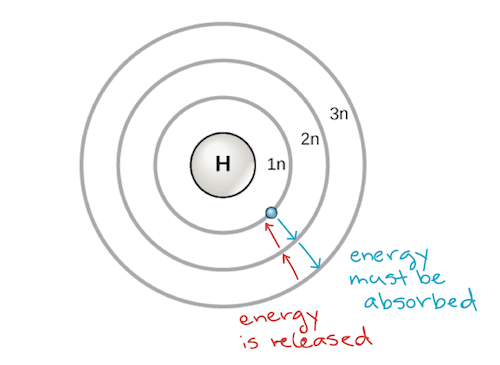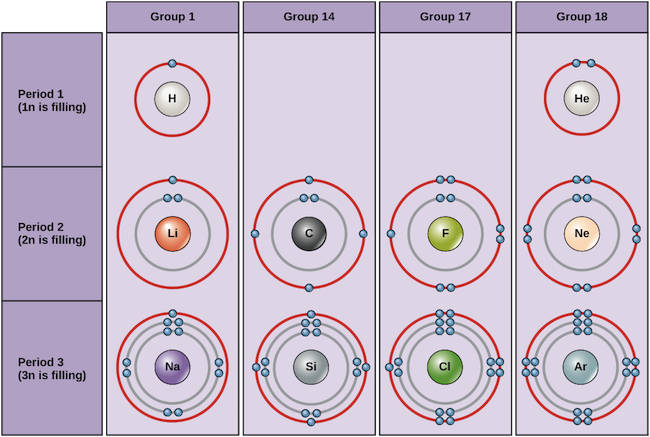The periodic table, electron shells, and orbitals
Introduction
At some point in your chemistry education, you may have been introduced to the song “The Elements,” in which Tom Lehrer does a rapid-fire musical rendition of all the elements’ names. Like me, you may even have been offered the opportunity to memorize this song for extra credit. If so, it’s possible that you still remember the names of all the elements, which is an impressive feat—not to mention a fun trick to pull out at cocktail parties.
If you’ve memorized the names of the elements, does that mean you’ll never need a periodic table again? Well … probably not. That’s because the periodic table isn’t just a big bucket that holds all of the elements. Instead, it’s more like a filing system. The position of each element in the table gives important information about its structure, properties, and behavior in chemical reactions. Specifically, an element’s position in the periodic table helps you figure out its electron configuration, how the electrons are organized around the nucleus. Atoms use their electrons to participate in chemical reactions, so knowing an element’s electron configuration allows you to predict its reactivity—whether, and how, it will interact with atoms of other elements.
In this article, we’ll look in more detail at the periodic table, how atoms organize their electrons, and how this allows us to predict the reactivity of elements.
The periodic table
By convention, elements are organized in the periodic table, a structure that captures important patterns in their behavior. Devised by Russian chemist Dmitri Mendeleev (1834–1907) in 1869, the table places elements into columns—groups—and rows—periods—that share certain properties. These properties determine an element’s physical state at room temperature—gas, solid, or liquid)—as well as its chemical reactivity, the ability to form chemical bonds with other atoms.
In addition to listing the atomic number for each element, the periodic table also displays the element’s relative atomic mass, the weighted average for its naturally occurring isotopes on earth. Looking at hydrogen, for example, its symbol, \text{H,}H,H, comma and name appear, as well as its atomic number of one—in the upper left-hand corner—and its relative atomic mass of 1.01.
Differences in chemical reactivity between elements are based on the number and spatial distribution of their electrons. If two atoms have complementary electron patterns, they can react and form a chemical bond, creating a molecule or compound. As we will see below, the periodic table organizes elements in a way that reflects their number and pattern of electrons, which makes it useful for predicting the reactivity of an element: how likely it is to form bonds, and with which other elements.
Electron shells and the Bohr model
An early model of the atom was developed in 1913 by the Danish scientist Niels Bohr (1885–1962). The Bohr model shows the atom as a central nucleus containing protons and neutrons, with the electrons in circular electron shells at specific distances from the nucleus, similar to planets orbiting around the sun. Each electron shell has a different energy level, with those shells closest to the nucleus being lower in energy than those farther from the nucleus. By convention, each shell is assigned a number and the symbol n—for example, the electron shell closest to the nucleus is called 1n. In order to move between shells, an electron must absorb or release an amount of energy corresponding exactly to the difference in energy between the shells. For instance, if an electron absorbs energy from a photon, it may become excited and move to a higher-energy shell; conversely, when an excited electron drops back down to a lower-energy shell, it will release energy, often in the form of heat.
Atoms, like other things governed by the laws of physics, tend to take on the lowest-energy, most stable configuration they can. Thus, the electron shells of an atom are populated from the inside out, with electrons filling up the low-energy shells closer to the nucleus before they move into the higher-energy shells further out. The shell closest to the nucleus, 1n, can hold two electrons, while the next shell, 2n, can hold eight, and the third shell, 3n, can hold up to eighteen.
The number of electrons in the outermost shell of a particular atom determines its reactivity, or tendency to form chemical bonds with other atoms. This outermost shell is known as the valence shell, and the electrons found in it are called valence electrons. In general, atoms are most stable, least reactive, when their outermost electron shell is full. Most of the elements important in biology need eight electrons in their outermost shell in order to be stable, and this rule of thumb is known as the octet rule. Some atoms can be stable with an octet even though their valence shell is the 3n shell, which can hold up to 18 electrons. We will explore the reason for this when we discuss electron orbitals below.
Examples of some neutral atoms and their electron configurations are shown below. In this table, you can see that helium has a full valence shell, with two electrons in its first and only, 1n, shell. Similarly, neon has a complete outer 2n shell containing eight electrons. These electron configurations make helium and neon very stable. Although argon does not technically have a full outer shell, since the 3n shell can hold up to eighteen electrons, it is stable like neon and helium because it has eight electrons in the 3n shell and thus satisfies the octet rule. In contrast, chlorine has only seven electrons in its outermost shell, while sodium has just one. These patterns do not fill the outermost shell or satisfy the octet rule, making chlorine and sodium reactive, eager to gain or lose electrons to reach a more stable configuration.
Electron configurations and the periodic table
Elements are placed in order on the periodic table based on their atomic number, how many protons they have. In a neutral atom, the number of electrons will equal the number of protons, so we can easily determine electron number from atomic number. In addition, the position of an element in the periodic table—its column, or group, and row, or period—provides useful information about how those electrons are arranged.
If we consider just the first three rows of the table, which include the major elements important to life, each row corresponds to the filling of a different electron shell: helium and hydrogen place their electrons in the 1n shell, while second-row elements like Li start filling the 2n shell, and third-row elements like Na continue with the 3n shell. Similarly, an element’s column number gives information about its number of valence electrons and reactivity. In general, the number of valence electrons is the same within a column and increases from left to right within a row. Group 1 elements have just one valence electron and group 18 elements have eight, except for helium, which has only two electrons total.


